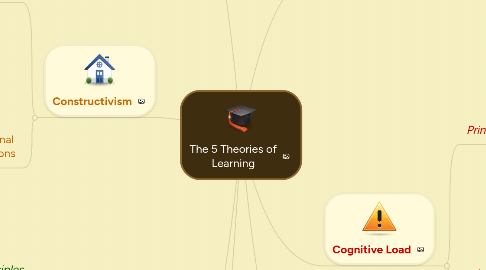
1. Cognitivism
1.1. General Principles
1.1.1. our thinking
1.1.2. (what is going on in our brains) memory
1.1.3. the mind is a computer, recall stored information
1.1.4. Piaget
1.1.5. learning happens when you move from unbalance to knowledge
1.2. education implications
1.2.1. attach an image to the learning
1.2.2. grab someones attention and then help them make sense and store it
2. Connectivism
2.1. General principles
2.1.1. To help people interact and find information faster online.
2.2. Educational Implications
2.2.1. 1)Learning and knowledge rests in diversity of opinions.
2.2.2. 2)Learning is a process of connecting specialized nodes or information sources.
2.2.3. 3)Learning may reside in non-human appliances.
2.2.4. 4)Maintaining and nurturing connections is needed to facilitate continual learning.
2.2.5. 5)Perceiving connections between fields, ideas and concepts is a core skill.
2.2.6. 6)Currency (accurate, up-to-date knowledge) is the intent of learning activities.
3. Behaviorism
3.1. General Principles
3.1.1. a change in external behavior achieved through a large amount of repetition of desired actions, the reward of good habits and the discouragement of bad habits.
3.2. educational implications
3.2.1. a change of behaviour in response to a stimulus in the environment.
3.2.2. observable response
3.2.3. learning has occurred when we receive regular expected responses
3.2.4. nature vs Nurture
3.2.5. “the mind is a black box”
4. Constructivism
4.1. General Principles
4.1.1. looks at the mind as a network -begin with problems then learn basic skills - based on own experience - learner learns when you construct something that others can see, question or use
4.2. Educational Implications
4.2.1. 1). Establishment of a cooperative, sociomoral atmosphere 2). Appeal to children’s interests 6). Provide adequate time for children’s investigation and in-depth engagement . 7). Link ongoing documentation and assessment with curriculum activities
5. Cognitive Load
5.1. Principles
5.1.1. Cognitive Load Theory (CLT) is an information processing theory used to explain the limits of working memory based on current knowledge of human cognitive architecture. Cognitive architecture refers to the concept of our minds having structures such as working memory, long term memory, and schemas.
5.2. educational Implications
5.2.1. If the resources of working memory are exceeded then learning will be ineffective.
5.2.2. The process of learning requires working memory to be actively engaged in the comprehension (and processing) of instructional material to encode to-be-learned information into long term memory.
5.2.3. Working memory is extremely limited.
5.2.4. Long term memory is essentially unlimited.
6. TPAK
6.1. Technological Pedagogical Content Knowledge (TPACK) is a framework that identifies the knowledge teachers need to teach effectively with technology. TPACK also emphasizes the new kinds of knowledge that lie at the intersections between them, representing four more knowledge bases teachers applicable to teaching with technology: Pedagogical Content Knowledge (PCK), Technological Content Knowledge (TCK), Technological Pedagogical Knowledge (TPK), and the intersection of all three circles, Technological Pedagogical Content Knowledge (TPACK). http://www.matt-koehler.com/tpack/wp-content/uploads/tpack.jpg
7. Philosophy of Teachnology
7.1. Genral principles
7.1.1. http://www.slideshare.net/bethanyvsmith/why-use-technology-in-the-classroom. Philosophy of Teachnology is based on the individuals beliefs on how technology can be integrated with our students inside the classroom.
